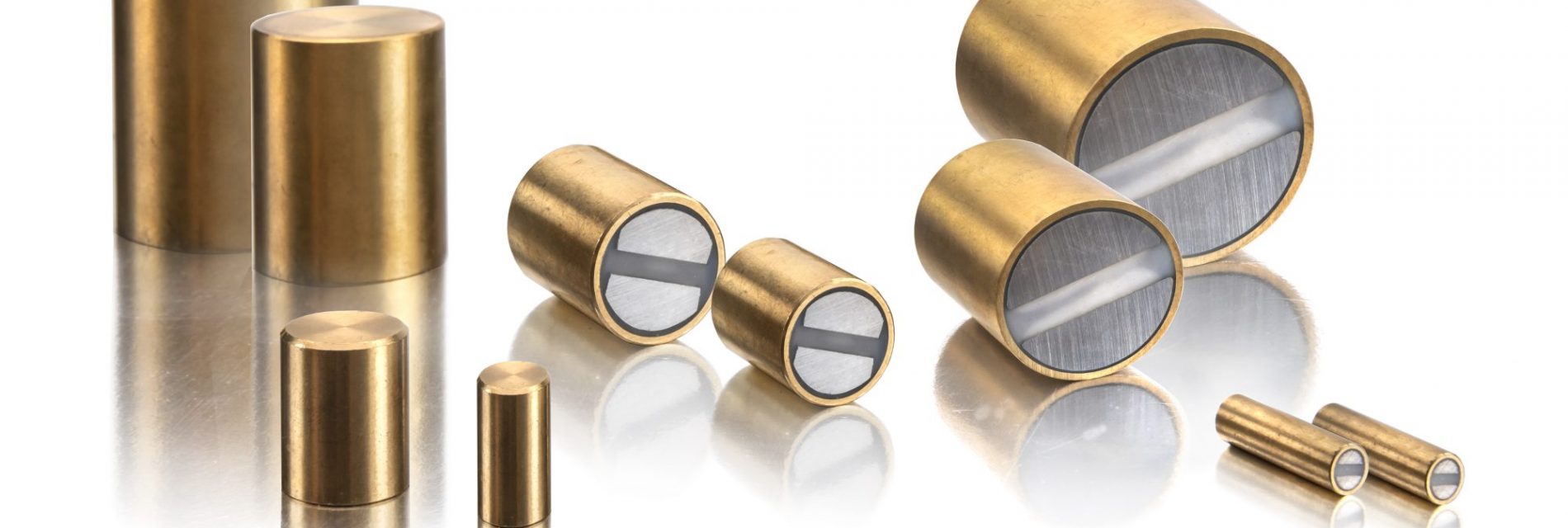ORIGINS AND COMPOSITION
This type of ferromagnetic alloy appeared in the 1980s.
It belongs to a family of 15 metals, including cerium and lanthanum, known as ‘rare earths’. Contrary to what the name suggests, these metals are not rare, but dispersed in nature. Cerium is more abundant than cobalt, thulium more widespread than tin.
The industrial development of these metals is more recent because of the difficulty of extracting the ores and especially of separating them.
Some rare earths are ferromagnetic and give rise to compounds with high crystalline anisotropy. Hence the idea of combining rare earth atoms for anisotropy and cobalt atoms with a high Curie point in the same crystal to make magnets. This is Samarium cobalt SmCo.
Two main types are used:
SmCo5 grade Essentially 60% cobalt and samarium.
Sm2Co17 grade 40% cobalt and samarium, with small amounts of iron and copper added.
Gadolinium is sometimes added to improve the thermal behaviour of magnets (so-called “stabilised” grades).
MANUFACTURING PROCESS
The alloy is ground to a fine powder and pressed into moulds. During the pressing process, a magnetic field may be applied (anisotropic magnets). The compressed parts are then sintered at high temperature (1100°C) and heat treated to improve their magnetic performance.
The base material is pyrophoric (ignites spontaneously on contact with air). Until sintering, all processes are carried out under neutral gas (nitrogen). Due to shrinkage and deformation during sintering, machining is necessary to achieve good geometric accuracy of the parts. Precautions must be taken when handling the material as it is very fragile and sensitive to shocks and mechanical stresses.
MAGNIFICATION
The magnetic field required to magnetise samarium magnets is considerable: of the order of 25 to 30 kOe for the SmCO5 grade, it reaches 60 kOe for the SM2CO17 (i.e. twice as much as for a neodymium magnet.
The magnetic orientation of a samarium magnet cannot be changed. Most of the time they are delivered magnetised.
The most remarkable property is the very high resistance to demagnetisation. In the classic Alnico or ferrite grades, when a field equal to the magnet’s coercive field (bHc) is applied to the magnet, there is no external action (no attraction). This is because the magnetisation has been more or less destroyed. If this opposing field is removed, the magnet will remain substantially unmagnetised.
The same experiment with a samarium magnet is surprising: as long as a field equal to the coercive field is opposed, the magnet also loses all its attraction, but it is only opposed by this field. As soon as it is removed, the magnet regains all its power.
The samarium magnet can be compared to a spring that regains its dimensions after being crushed, whereas other types of magnets are “soft” springs that have to be re-tensioned after use.
IMPLEMENTATION
Due to their very high intrinsic coercive field, SmCo magnets can be magnetised before assembly in the final magnetic circuit without loss of performance. In particular for Sm2Co17 grades, magnetisation after assembly may not be possible.
Compression forming and sintering require simple prismatic shapes. The compression ratios required are high so that one is often limited to small parts (a few mm to a few ten cm). (a few mm to a few ten cm). For larger magnets, assemblies are required.
The high specific magnetic energy of Sm magnets allows for a massive reduction in the size of magnetic circuits.
SENSITIVITY TO CORROSION
SmCo magnets are unaffected by atmospheric agents. However, atmospheres likely to produce hydrogen strongly attack the magnet. A coating is recommended for use in chlorinated and saline environments.
APPLICATIONS
They are related to the two remarkable properties of samarium:
A high specific energy (BH max)
A very high coercivity.
We therefore find either miniaturised magnets,
Examples: watch motors, magnetic lenses for satellite radio tubes, aircraft gyroscopes, etc.
or subjected to strong opposing fields,
Examples: motors with high starting torque, magnetic bearings, computer printers…

